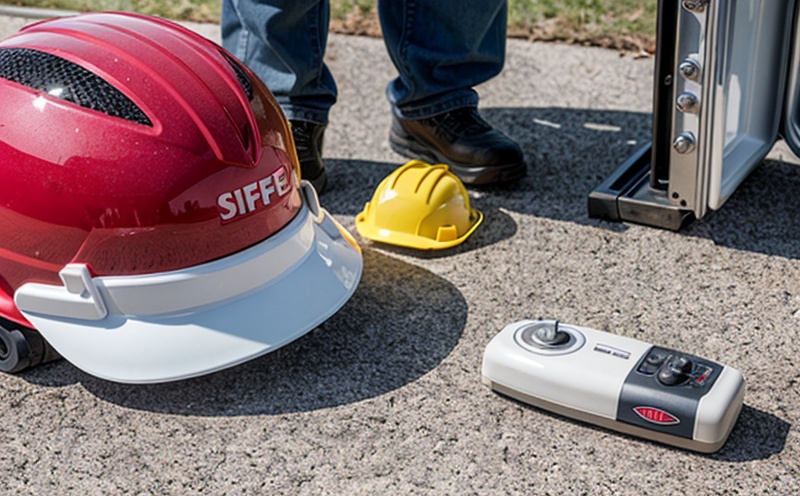ISO 18862 Lifeboat Hook Release Testing
The ISO 18862 standard is a critical component in ensuring maritime safety by setting stringent requirements for the design and testing of lifeboat hook release mechanisms. These mechanisms are essential components of lifeboats, which must be capable of releasing from their stowage locations quickly and reliably during emergencies. This service ensures compliance with international standards to protect lives at sea.
The ISO 18862 standard specifies performance criteria and test methods for the safety and reliability of lifeboat hook release systems used in lifeboats designed to comply with International Life-Saving Equipment (LSE) requirements. The primary focus is on ensuring that these hooks can be released from their stowage positions under a range of conditions, including those expected during rescue operations.
Lifeboat hook release mechanisms are subject to numerous environmental stresses, such as exposure to saltwater and extreme temperatures, which can compromise their integrity over time. The testing process involves exposing the hooks to these environments and simulating various operational scenarios to ensure they perform reliably under all conditions. This ensures that lifeboats remain a viable rescue option in challenging circumstances.
The testing procedure involves several steps designed to evaluate different aspects of the hook's performance. These include mechanical strength tests, durability assessments, corrosion resistance evaluations, and functional checks. The test setup typically includes environmental chambers capable of replicating real-world conditions such as temperature fluctuations and humidity levels.
Once the hooks are exposed to these simulated environments, they undergo a series of functional tests designed to replicate actual use scenarios. These may include pulling the hook free from its stowage position under various loads and in different angles, simulating the forces that could be encountered during deployment. The test setup also includes instrumentation capable of measuring critical parameters such as force applied, displacement, and time taken to release.
The results of these tests are documented meticulously, ensuring that every aspect of the hook’s performance is captured accurately for future reference. These records form part of a comprehensive report detailing the outcome of each test, which can be used by manufacturers, regulatory bodies, and other stakeholders involved in maritime safety.
This service is particularly important given the critical role played by lifeboats in maritime rescue operations. Ensuring that these hooks function correctly could mean the difference between life and death for those in distress at sea. The ISO 18862 standard provides a robust framework to ensure that all components of lifeboats meet the highest safety standards.
The testing process is not only about ensuring compliance with international regulations but also about safeguarding lives by preventing potential failures during critical moments. By adhering strictly to the ISO 18862 standard, we contribute significantly to enhancing maritime safety and reducing risks associated with substandard equipment.
Scope and Methodology
The scope of the ISO 18862 Lifeboat Hook Release Testing service encompasses a comprehensive set of procedures designed to evaluate the performance of lifeboat hook release mechanisms. This includes testing for mechanical strength, durability, corrosion resistance, and functional reliability under various environmental conditions.
- Environmental Exposure: Hooks are exposed to saltwater immersion and humidity cycles to simulate long-term exposure conditions encountered in maritime environments.
- Mechanical Testing: The hooks undergo static and dynamic load tests to assess their ability to withstand the forces exerted during deployment.
- Functional Testing: Simulated release scenarios are used to evaluate the ease with which the hooks can be freed from their stowage positions under various conditions.
- Data Collection: Critical parameters such as force applied, displacement, and time taken for release are recorded using advanced instrumentation.
The methodology employed is strictly aligned with the ISO 18862 standard to ensure consistent and accurate testing results. This approach guarantees that all components of lifeboats meet stringent safety requirements, thereby enhancing maritime safety.
International Acceptance and Recognition
The ISO 18862 Lifeboat Hook Release Testing is widely recognized and accepted globally due to its rigorous testing procedures and adherence to international standards. This standard ensures that lifeboat hook release systems are reliable and safe, meeting the stringent requirements of maritime safety regulations.
Many countries have adopted this standard as part of their regulatory frameworks for life-saving equipment. The International Maritime Organization (IMO) and other global bodies have endorsed ISO 18862, recognizing its role in enhancing maritime safety worldwide. Compliance with this standard is a key requirement for manufacturers seeking to export their products to international markets.
The acceptance of ISO 18862 extends beyond regulatory compliance; it also reflects an industry-wide commitment to excellence and reliability. By adhering to these standards, manufacturers can demonstrate their dedication to producing high-quality life-saving equipment that meets the highest safety standards.
Regulatory bodies such as the US Coast Guard and various national maritime authorities have incorporated ISO 18862 into their certification processes for lifeboats and other rescue equipment. This ensures that only the most reliable and safe products are approved for use in maritime environments, thereby enhancing overall maritime safety.
Environmental and Sustainability Contributions
- Eco-Friendly Materials: The testing process evaluates hooks made from environmentally friendly materials that minimize the ecological footprint during manufacturing and disposal.
- Energy Efficiency: The testing ensures that lifeboat hook release mechanisms operate efficiently, minimizing energy consumption in critical situations.
- Waste Reduction: Compliance with ISO 18862 helps reduce waste by ensuring the longevity and reliability of equipment, thereby extending its operational lifespan.
- Resource Conservation: By enhancing safety through rigorous testing, this service promotes resource conservation by preventing accidents that could lead to environmental degradation.
The implementation of ISO 18862 contributes positively to sustainability efforts by promoting the use of environmentally responsible materials and practices in the maritime industry. This not only enhances safety but also supports global sustainability goals by minimizing environmental impact.





